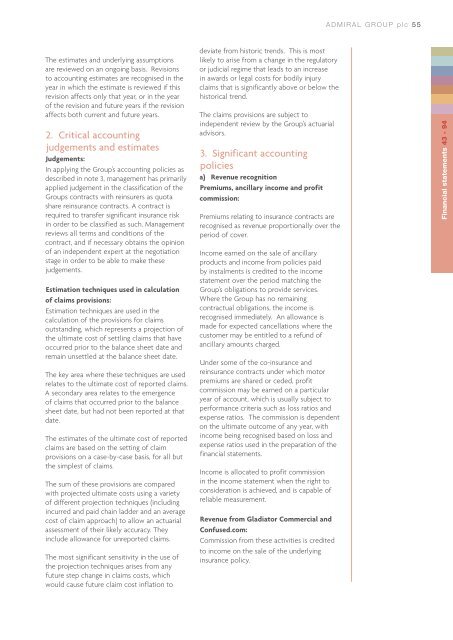annual report 2007 - the Admiral Group plc
annual report 2007 - the Admiral Group plc
annual report 2007 - the Admiral Group plc
Create successful ePaper yourself
Turn your PDF publications into a flip-book with our unique Google optimized e-Paper software.
ADMIRAL GROUP <strong>plc</strong> 55The estimates and underlying assumptionsare reviewed on an ongoing basis. Revisionsto accounting estimates are recognised in <strong>the</strong>year in which <strong>the</strong> estimate is reviewed if thisrevision affects only that year, or in <strong>the</strong> yearof <strong>the</strong> revision and future years if <strong>the</strong> revisionaffects both current and future years.2. Critical accountingjudgements and estimatesJudgements:In applying <strong>the</strong> <strong>Group</strong>’s accounting policies asdescribed in note 3, management has primarilyapplied judgement in <strong>the</strong> classification of <strong>the</strong><strong>Group</strong>s contracts with reinsurers as quotashare reinsurance contracts. A contract isrequired to transfer significant insurance riskin order to be classified as such. Managementreviews all terms and conditions of <strong>the</strong>contract, and if necessary obtains <strong>the</strong> opinionof an independent expert at <strong>the</strong> negotiationstage in order to be able to make <strong>the</strong>sejudgements.Estimation techniques used in calculationof claims provisions:Estimation techniques are used in <strong>the</strong>calculation of <strong>the</strong> provisions for claimsoutstanding, which represents a projection of<strong>the</strong> ultimate cost of settling claims that haveoccurred prior to <strong>the</strong> balance sheet date andremain unsettled at <strong>the</strong> balance sheet date.The key area where <strong>the</strong>se techniques are usedrelates to <strong>the</strong> ultimate cost of <strong>report</strong>ed claims.A secondary area relates to <strong>the</strong> emergenceof claims that occurred prior to <strong>the</strong> balancesheet date, but had not been <strong>report</strong>ed at thatdate.The estimates of <strong>the</strong> ultimate cost of <strong>report</strong>edclaims are based on <strong>the</strong> setting of claimprovisions on a case-by-case basis, for all but<strong>the</strong> simplest of claims.The sum of <strong>the</strong>se provisions are comparedwith projected ultimate costs using a varietyof different projection techniques (includingincurred and paid chain ladder and an averagecost of claim approach) to allow an actuarialassessment of <strong>the</strong>ir likely accuracy. Theyinclude allowance for un<strong>report</strong>ed claims.The most significant sensitivity in <strong>the</strong> use of<strong>the</strong> projection techniques arises from anyfuture step change in claims costs, whichwould cause future claim cost inflation todeviate from historic trends. This is mostlikely to arise from a change in <strong>the</strong> regulatoryor judicial regime that leads to an increasein awards or legal costs for bodily injuryclaims that is significantly above or below <strong>the</strong>historical trend.The claims provisions are subject toindependent review by <strong>the</strong> <strong>Group</strong>’s actuarialadvisors.3. Significant accountingpoliciesa) Revenue recognitionPremiums, ancillary income and profitcommission:Premiums relating to insurance contracts arerecognised as revenue proportionally over <strong>the</strong>period of cover.Income earned on <strong>the</strong> sale of ancillaryproducts and income from policies paidby instalments is credited to <strong>the</strong> incomestatement over <strong>the</strong> period matching <strong>the</strong><strong>Group</strong>’s obligations to provide services.Where <strong>the</strong> <strong>Group</strong> has no remainingcontractual obligations, <strong>the</strong> income isrecognised immediately. An allowance ismade for expected cancellations where <strong>the</strong>customer may be entitled to a refund ofancillary amounts charged.Under some of <strong>the</strong> co-insurance andreinsurance contracts under which motorpremiums are shared or ceded, profitcommission may be earned on a particularyear of account, which is usually subject toperformance criteria such as loss ratios andexpense ratios. The commission is dependenton <strong>the</strong> ultimate outcome of any year, withincome being recognised based on loss andexpense ratios used in <strong>the</strong> preparation of <strong>the</strong>financial statements.Income is allocated to profit commissionin <strong>the</strong> income statement when <strong>the</strong> right toconsideration is achieved, and is capable ofreliable measurement.Revenue from Gladiator Commercial andConfused.com:Commission from <strong>the</strong>se activities is creditedto income on <strong>the</strong> sale of <strong>the</strong> underlyinginsurance policy.Financial statements 43 - 94
















